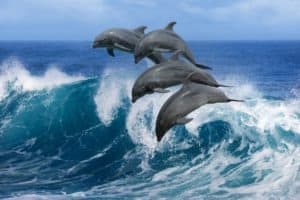Dolphins and porpoises are marine mammals that belong to the suborder Odontoceti within the order Cetacea. Dolphins are generally larger than porpoises, with longer snouts and more curved dorsal fins. They are also more social and often found in larger groups, known as pods. Porpoises, on the other hand, have shorter snouts and triangular dorsal fins. They are not as social and are usually found in smaller groups. Both dolphins and porpoises are highly intelligent animals that use a variety of vocalizations and body language to communicate with one another. Dolphins are known for their playful behavior and acrobatic displays. They often ride the bow wave of boats and leap out of the water. Despite their similarities, there are obvious differences between dolphins and porpoises, including their physical characteristics, behavior, and habitat preferences.

Dolphins, like this bottlenose dolphin (
Tursiops truncates), are generally larger than porpoises, with longer snouts and more curved dorsal fins.
©Tory Kallman/Shutterstock.com
Appearance
Dolphins and porpoises have several physical features that set them apart.
- Size: Dolphins are generally larger than porpoises. The smallest dolphin species, the Maui dolphin (Cephalorhynchus hectori maui), is only 4 feet (1.2 meters) long. The largest dolphin species, the killer whale (Orcinus orca), can reach lengths of up to 32 feet (9.8 meters). Porpoises, on the other hand, are generally smaller. The smallest species, the vaquita (Phocoena sinus) reaches lengths of just 5 feet (1.5 meters). The largest species, the Dall’s porpoise (Phocoenoides dalli), reaches lengths of up to 7 feet (2.1 meters).
- Beaks: One of the biggest differences between dolphins and porpoises is found in their beaks. Dolphins have long, pointed beaks that are used for catching fish and other prey. Porpoises have shorter, blunter beaks that are better suited for feeding on bottom-dwelling invertebrates.
- Dorsal fins: Dolphins have larger dorsal fins that are curved or pointed. Porpoises have smaller, triangular dorsal fins that are more upright.
- Teeth: Dolphins have cone-shaped teeth that are used for grasping and tearing prey. Porpoises have spade-shaped teeth that are better suited for crushing hard-shelled prey.
- Coloration: Dolphins and porpoises also differ in their color. Dolphins are usually more brightly colored and may have a variety of patterns and markings. Porpoises are usually more uniformly gray or black with fewer distinctive markings.
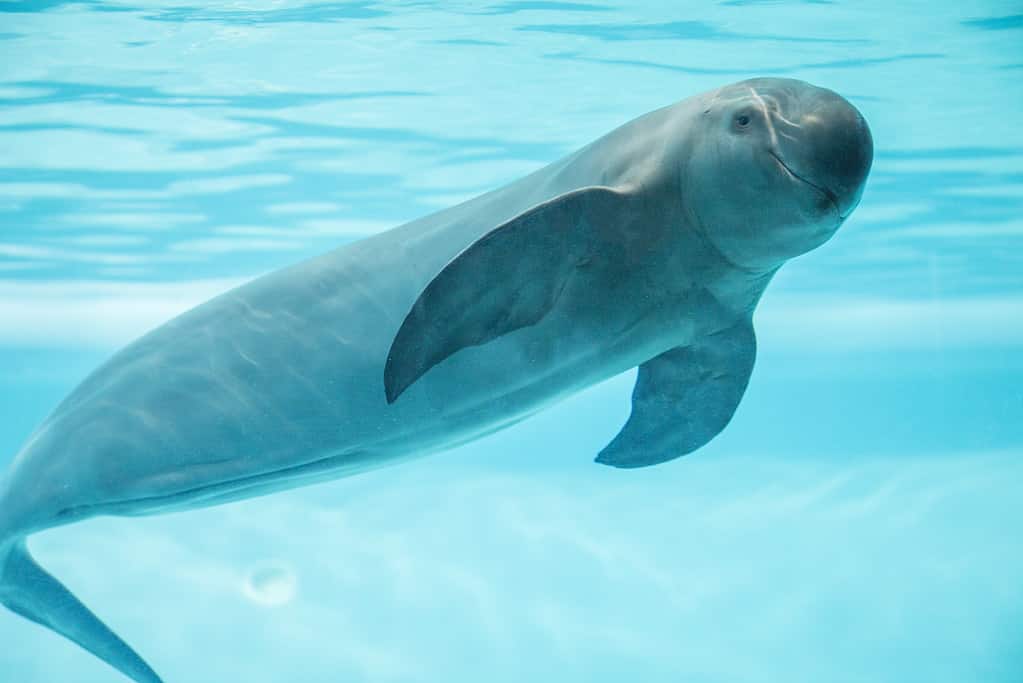
Porpoises, like this finless porpoise, have shorter, blunter beaks than dolphins, better suited for feeding on bottom-dwelling invertebrates.
©Takayuki Ohama/Shutterstock.com
Dolphins and Porpoises: Behavior
There are marked differences in the social behavior of dolphins and porpoises. And while porpoises and dolphins are both social animals, dolphins are generally considered to be more social than porpoises. They form larger and more complex social groups, sometimes numbering in the hundreds or even thousands of individuals. Porpoises usually form smaller pods of no more than a dozen individuals. Dolphins also engage in more social behaviors, such as playing with objects and each other. They engage in synchronized swimming, and communicate with a wider range of vocalizations. They also tend to be more acrobatic and may be seen leaping out of the water or riding waves.

Dolphins travel in pods, but a ‘megapod’ is likely a combination of a few different pods!
©iStock.com/lennjo
Porpoises tend to be more reserved and less interactive with humans than dolphins. They are usually shy and elusive animals that prefer to avoid contact with boats and humans. However, porpoises still have a strong social structure within their pods and rely on cooperation and communication to hunt and survive in their marine environment.

Porpoises tend to be more reserved and less social with humans than dolphins.
©iStock.com/PeakMystique
Dolphins and Porpoises: Habitat
Though dolphins and porpoises inhabit marine environments, they tend to have slightly different habitat desires. Dolphins are found in a wide range of marine habitat environments, from shallow coastal waters to the open ocean. They are highly adaptable and can thrive in a variety of environments, from warm tropical waters to cooler temperate regions. Some species of dolphins are also known to inhabit freshwater rivers. Dolphins will follow schools of fish, which can lead them to travel long distances and migrate seasonally.
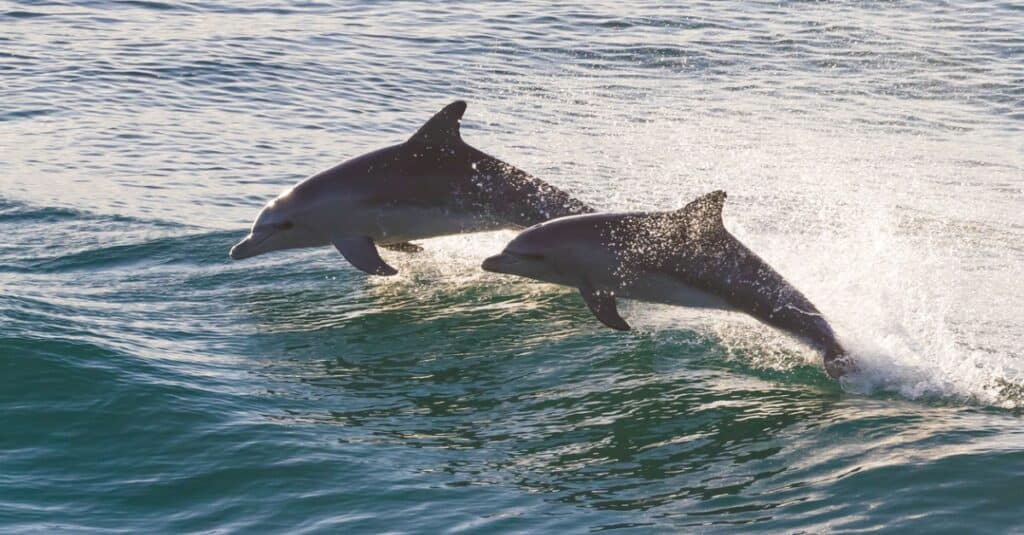
Dolphins are intrigued by the motion, sound, and also disturbance of water created by boats.
©Sally Hinton/Shutterstock.com
Porpoises, on the other hand, tend to prefer shallower waters and are often found in coastal areas or near the mouths of rivers. They tend to be less migratory than dolphins. Some species remain in the same general area year-round.

Porpoises, which have small, triangular dorsal fins, are much less social than dolphins.
©Snorre Roberg/Shutterstock.com
Dolphins and Porpoises: Communication
Both dolphins and porpoises use echolocation to navigate and locate prey, their vocalizations are actually quite different. Dolphins are known for their complex vocalizations, which can include whistles, clicks, and squawks, as well as more structured signature whistles that are unique to individual dolphins and used for communication with others. Some species of dolphins have even been known to mimic the sounds of other animals, including birds! Porpoises generally produce fewer types of vocalizations, usually using short bursts of clicks and whistles for communication and echolocation. Their echolocation clicks are usually higher in frequency than those of dolphins and are less complex in structure.

Some species of dolphins have even been known to mimic the sounds of other animals, including
birds
!
©IgorZh/Shutterstock.com
Taxonomy
Dolphins and porpoises are part of the order Cetacea, which also includes whales. Dolphins and porpoises are actually classified as toothed whales! Within the order Cetacea, there are four families of extant dolphins: Delphinidae, Iniidae, Pontoporiidae, and Platanistidae. Porpoises belong to the family Phocoenidae, which includes three genera: Neophocaena, Phocaena, and Phocoenoides
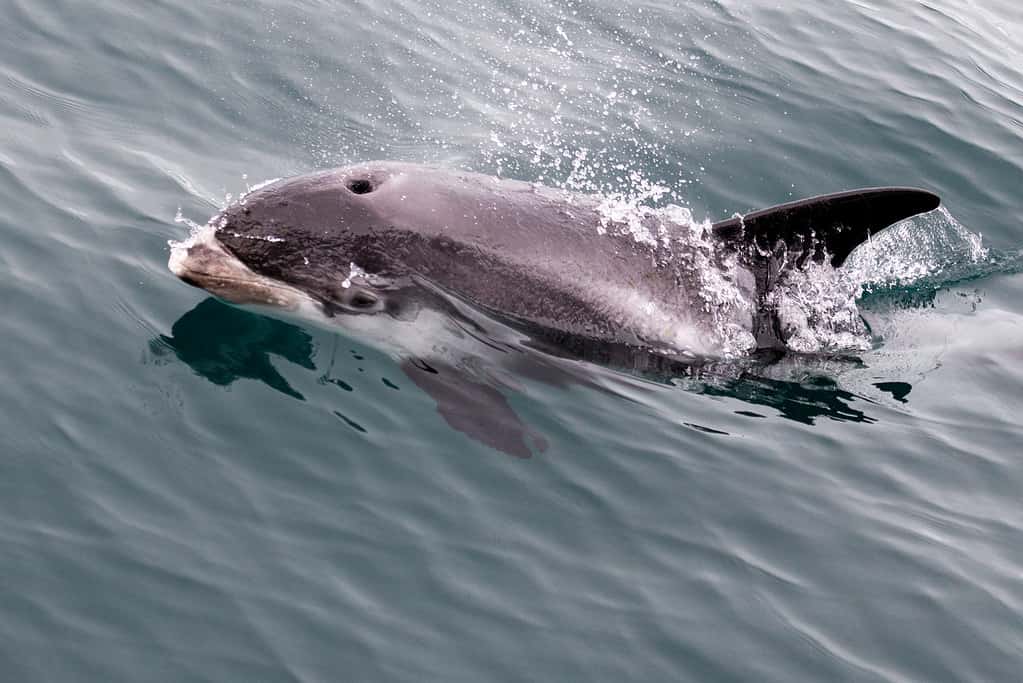
White-beaked dolphin (
Lagenorhynchus albirostris)
©Maria 81/Shutterstock.com
Dolphins
Dolphins are a diverse group of marine mammals that belong to four families, Delphinidae, Platanistidae, Iniidae, and Pontoporiidae. They are found in oceans and also rivers worldwide. There are over 40 different species of dolphins, each with its unique physical and behavioral characteristics, including size, coloration, and social behavior.
Delphinidae: Oceanic Dolphins
The Delphinidae family of dolphins, also known as oceanic dolphins, is one of the most diverse families of cetaceans. They can be found in all of the world’s oceans, as well as some major river systems. They are adapted to living in a variety of environments, from the warm waters of the tropics to the cold waters of the Arctic and Antarctic. Oceanic dolphins vary in size, from the Maui dolphin (Cephalorhynchus hectori maui), measuring only 4 feet (1.2 meters) in length, to the killer whale (Orcinus orca), which reaches lengths of up to 32 feet (10 meters).
Cephalorhynchus
Cephalorhynchus is a genus of marine mammals commonly known as the Southern Hemisphere or Right Whale dolphins. There are currently five recognized species in the genus:
- Cephalorhynchus commersonii – Commerson’s dolphin
- Cephalorhynchus eutropia – Chilean dolphin
- Cephalorhynchus heavisidii – Heaviside’s dolphin
- Cephalorhynchus hectori – Hector’s dolphin
- Cephalorhynchus hectori maui – Maui dolphin (subspecies of Hector’s dolphin)
All of these species are relatively small, ranging from 4-6 feet (1-2 m) in length and weigh between 80-165 pounds (40-75 kg). They are all found in the Southern Hemisphere, mostly in coastal waters and estuaries along the Southern coastlines of South America, as well as in New Zealand.
Cephalorhynchus dolphins have short, stocky bodies and also rounded foreheads that slope down to a short beak. They have a distinctive color pattern, with black heads, tails, and dorsal fins, and light gray or white bodies.
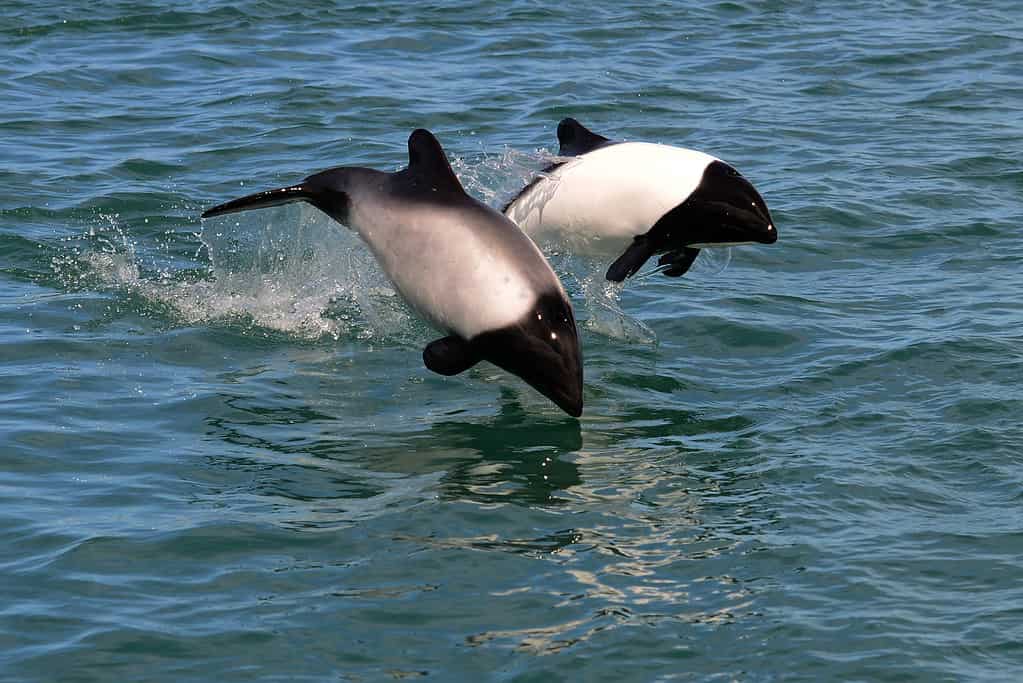
©si saber L/Shutterstock.com
Lagenodelphis
The genus Lagenodelphis is monotypic, containing only one species, Fraser’s dolphin (Lagenodelphis hosei) which is found in temperate, subtropical, and tropical oceans around the world. They live in areas with deep water (3,300 feet / 1000 meters deep).
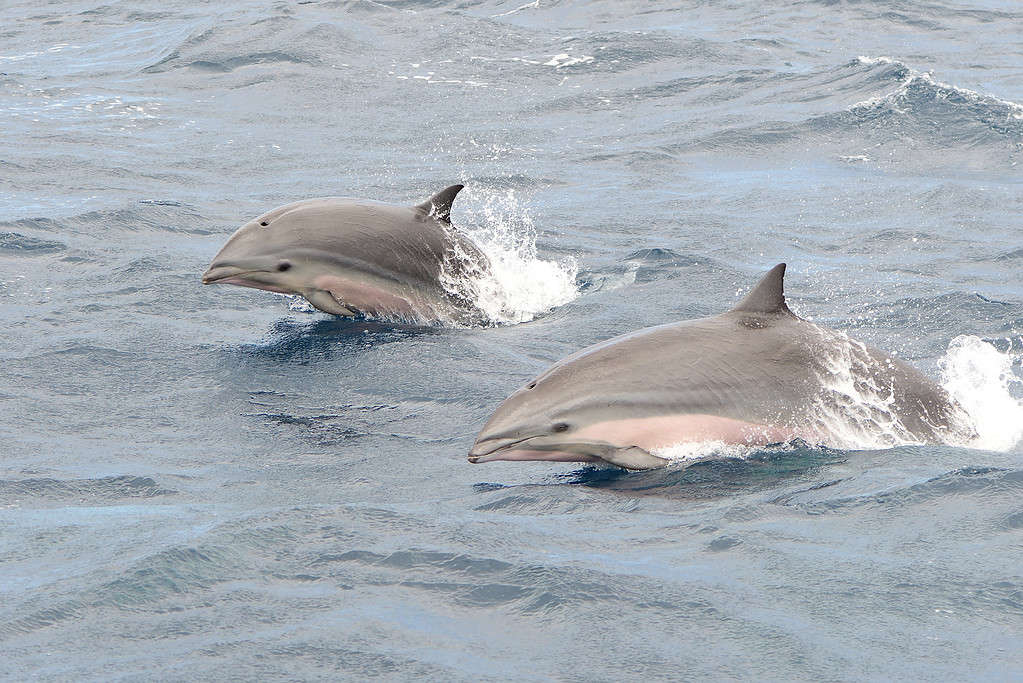
Fraser’s dolphin
(Lagenodelphis hosei).
©Tom Meaker/Shutterstock.com
Lagenorhynchus
The genus Lagenorhynchus contains small to medium-sized cetaceans that inhabit cold to temperate waters around the world. They are known for their distinctive color patterns, which often include bold stripes, patches, or spots, and for their acrobatic behavior, often leaping and also bow-riding in the wake of boats. Lagenorhynchus dolphins feed on a variety of small fish and squid, and are also usually found in groups or pods ranging from a few individuals to several hundred.
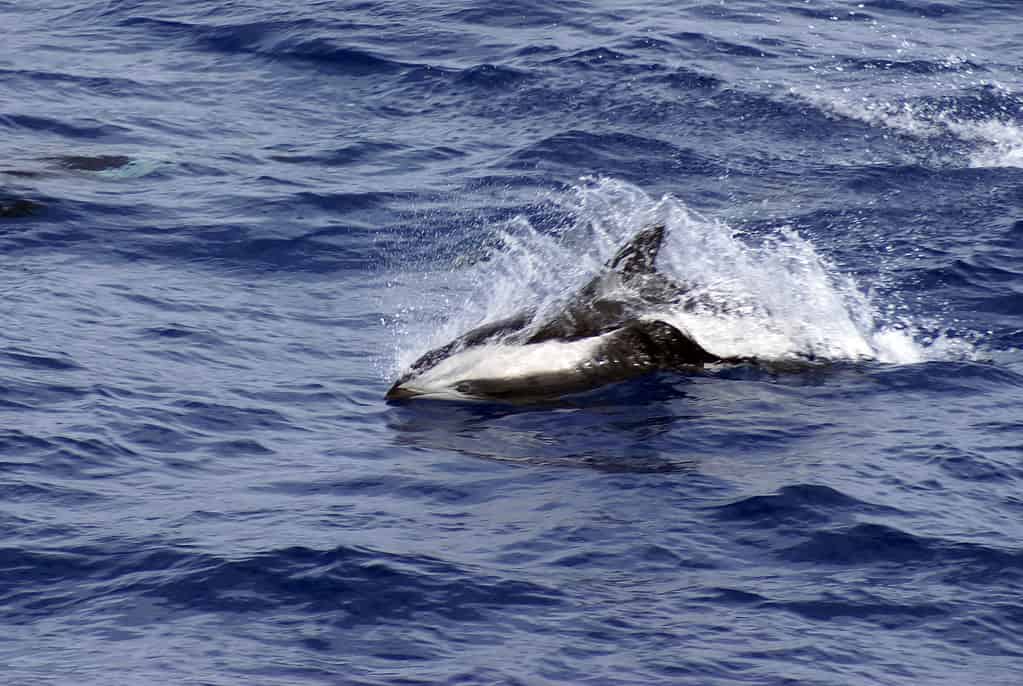
Hourglass dolphins (
Lagenorhynchus cruciger) inhabit the waters of the Drake Passage, which lies between the Southernmost tip of Argentina and Antarctica.
©Angela N Perryman/Shutterstock.com
The genus Lagenorhynchus contains six extant species: Atlantic white-sided dolphin (Lagenorhynchus acutus), Dusky dolphin (Lagenorhynchus obscurus), Hourglass dolphin (Lagenorhynchus cruciger), Pacific white-sided dolphin (Lagenorhynchus obliquidens), Peale’s dolphin (Lagenorhynchus australis), and also White-beaked dolphin (Lagenorhynchus albirostris).

Atlantic white-sided dolphins (
Lagenorhynchus acutus) swim in North Atlantic waters close to shore.
©David Persson/Shutterstock.com
Lissodelphis
There are two recognized species in the genus Lissodelphis: Northern right whale dolphins (Lissodelphis borealis) and Southern right whale dolphins (Lissodelphis peronii). Both species are found in different regions of the world’s oceans. The Northern right whale dolphin is found in the North Pacific Ocean, while the Southern right whale dolphin is found in the Southern Hemisphere, including the waters around Southern South America, Southern Africa, and New Zealand.
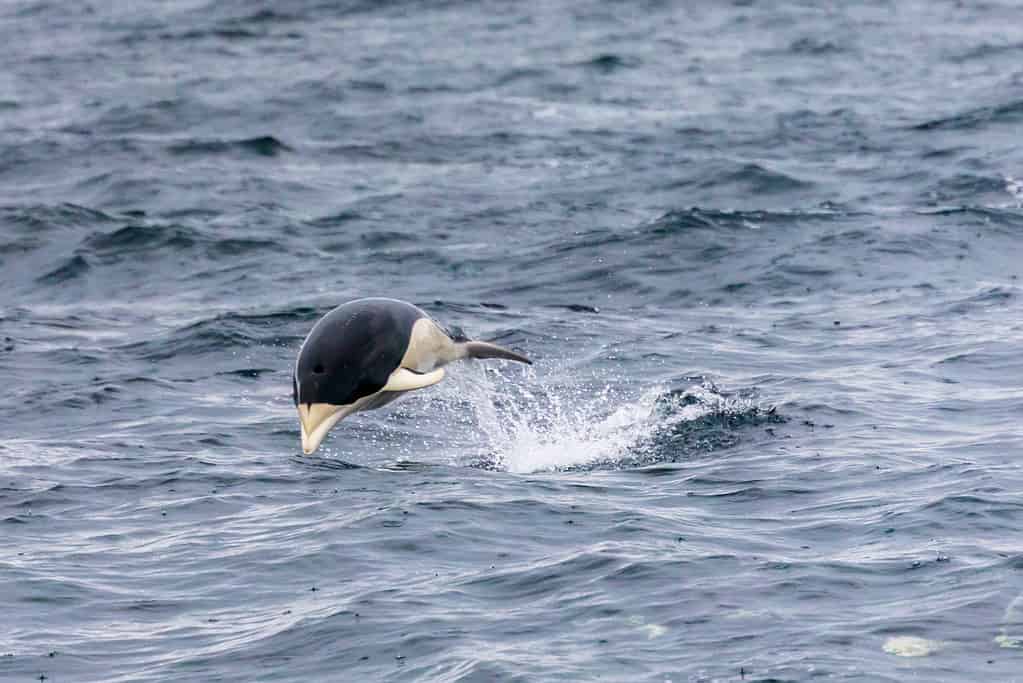
the Southern right whale dolphin is found in the Southern Hemisphere, including the waters around Southern South America, Southern Africa, and New Zealand.
©Circumnavigation/Shutterstock.com
Delphinus
There are three species of dolphins in the genus Delphinus. Known as common dolphins, they are medium-sized cetaceans, recognized for their high level of intelligence, social behavior, and acrobatic displays, including leaping, bow-riding, and also breaching. Common dolphins are found in temperate and tropical waters around the world, including the Atlantic, Pacific, and Indian Oceans. They are highly migratory and may travel long distances in search of food or breeding grounds.
Genus Delphinus includes the common dolphin (Delphinus delphis), long-beaked common dolphin (Delphinus capensis), and also short-beaked common dolphin (Delphinus delphis).

Long-beaked common dolphins (
Delphinus capensis) are an energetic species.
©Sergey Uryadnikov/Shutterstock.com
Tursiops
The genus Tursiops contains two extant species of dolphins, which are the common bottlenose dolphin (Tursiops truncatus) and the Indo-Pacific bottlenose dolphin (Tursiops aduncus). These species are closely related and share many physical and behavioral characteristics. They are found in coastal and offshore waters around the world, including the Atlantic, Pacific, and also Indian Oceans. They are known for their high level of intelligence, social behavior, and adaptability to different environments. Common bottlenose dolphins are also one of the most well-known and studied cetacean species, and are often featured in marine parks and aquariums due to their intelligence and trainability.
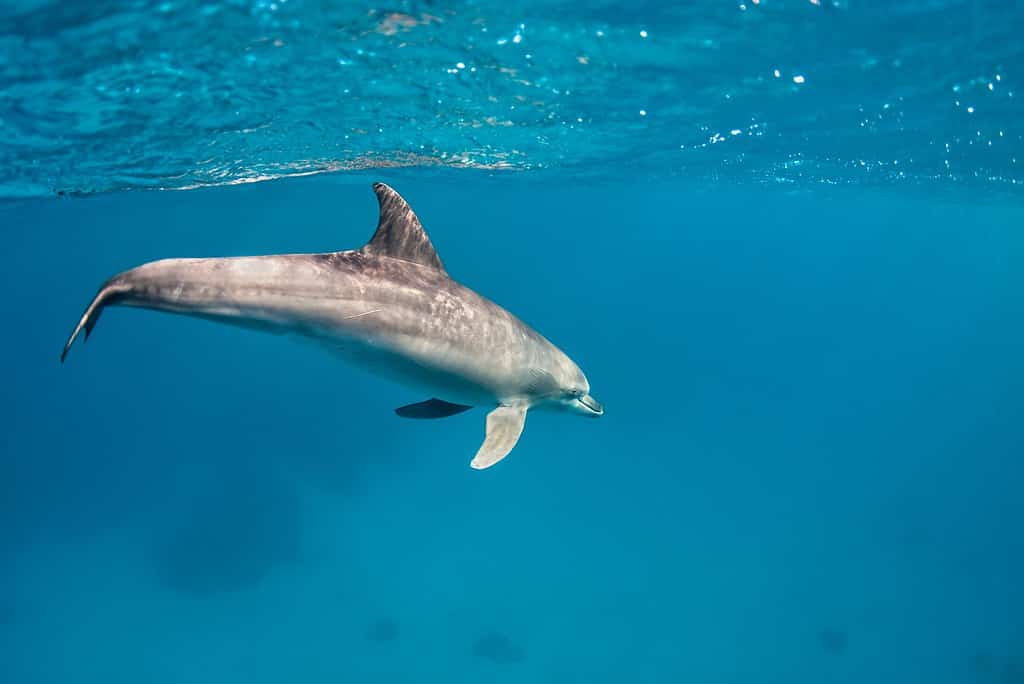
The Indo-Pacific bottlenose dolphin (
Tursiops aduncus) is smaller than the common bottlenose dolphin.
©Nicolas-SB/Shutterstock.com
Stenella
A genus of small to medium-sized dolphins that inhabit tropical and subtropical waters around the world, Stenella dolphins are highly social animals. Stenellas usually travel in large groups or pods, ranging in size from a few individuals to several hundred. They are known for their acrobatic displays, including breaching, spinning, and also leaping out of the water. These species have similar physical traits and behaviors but differ in their distribution and habitat desires. For example, the pantropical spotted dolphin is found in warm waters around the world, while the striped dolphin is more commonly found in cooler waters in the Mediterranean and eastern Atlantic.
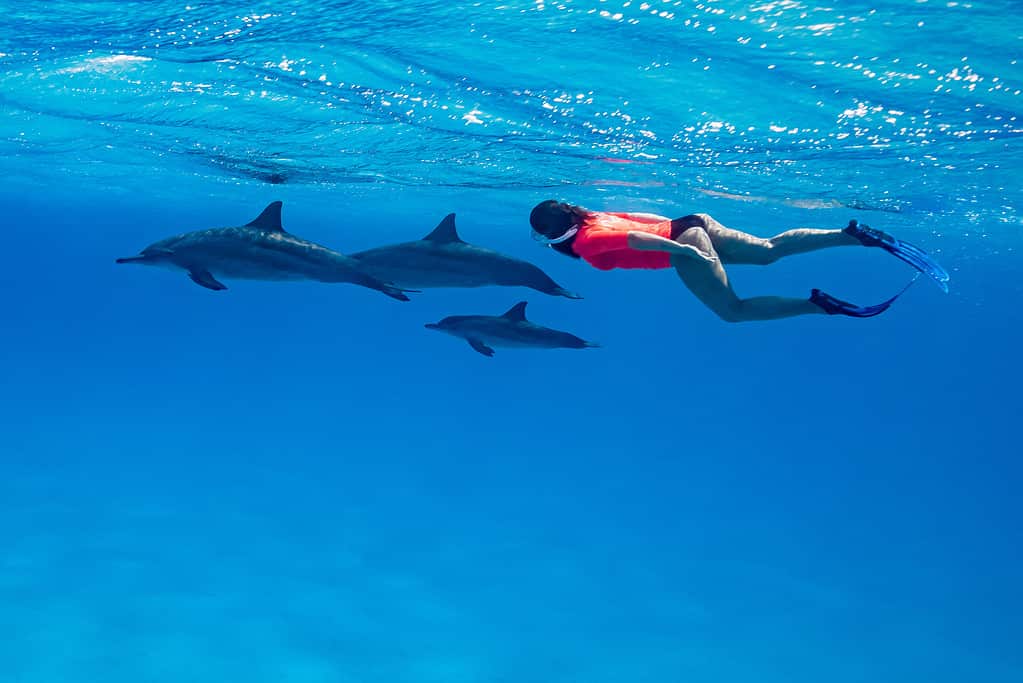
Snorkeler swimming with a small pod of spinner dolphins (
Stenella longirostris) in the
Red Sea.
©Subphoto.com/Shutterstock.com
There are five species within the genus Stenella, including the pantropical spotted dolphin (Stenella attenuata), the spinner dolphin (Stenella longirostris), the striped dolphin (Stenella coeruleoalba), the Atlantic spotted dolphin (Stenella frontalis), and the Clymene dolphin (Stenella clymene),
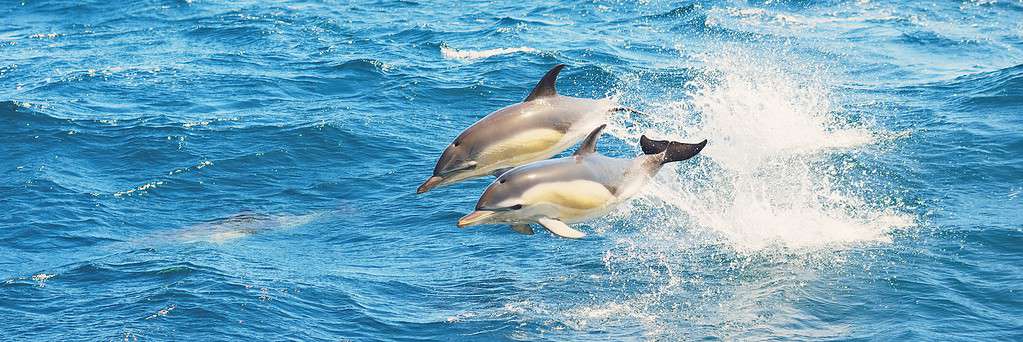
Striped dolphins (
Stenella coeruleoalba) off the coast of Spain.
©Aastels/Shutterstock.com
Steno
There is only one extant species within the genus Steno: the rough-toothed dolphin (Steno bredanensis). These dolphins are named for their distinctive teeth, which are serrated and give their jaw a rough appearance. Rough-toothed dolphins are found in warm oceanic waters around the world, usually in deep offshore waters, and are known for their vocalizations, including whistles, clicks, and squeaks. They usually feed on fish and squid and are known to hunt cooperatively in groups.
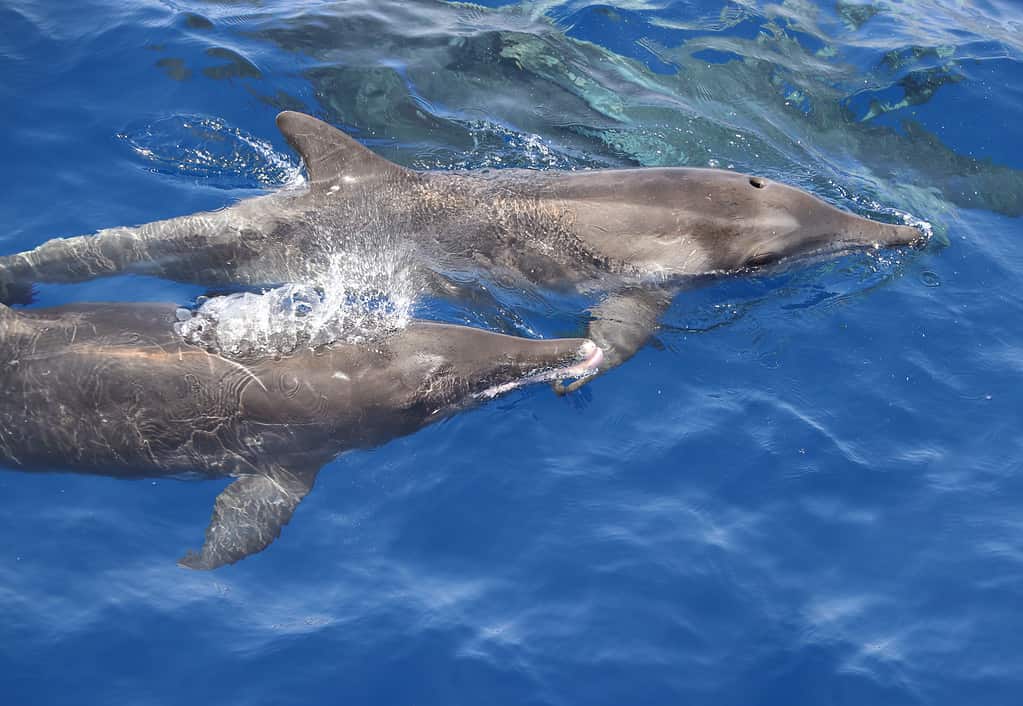
Rough-toothed dolphins (
Steno bredanensis) are named for their distinctive teeth, which are serrated.
©Gema Alvarez Fernandez/Shutterstock.com
Sousa
The genus Sousa is a group of coastal dolphins found in warm, shallow waters in the Indian, Pacific, and Atlantic Oceans. Members of this genus are characterized by their long beak and distinct coloration, which often includes a dark dorsal cape and lighter underside.
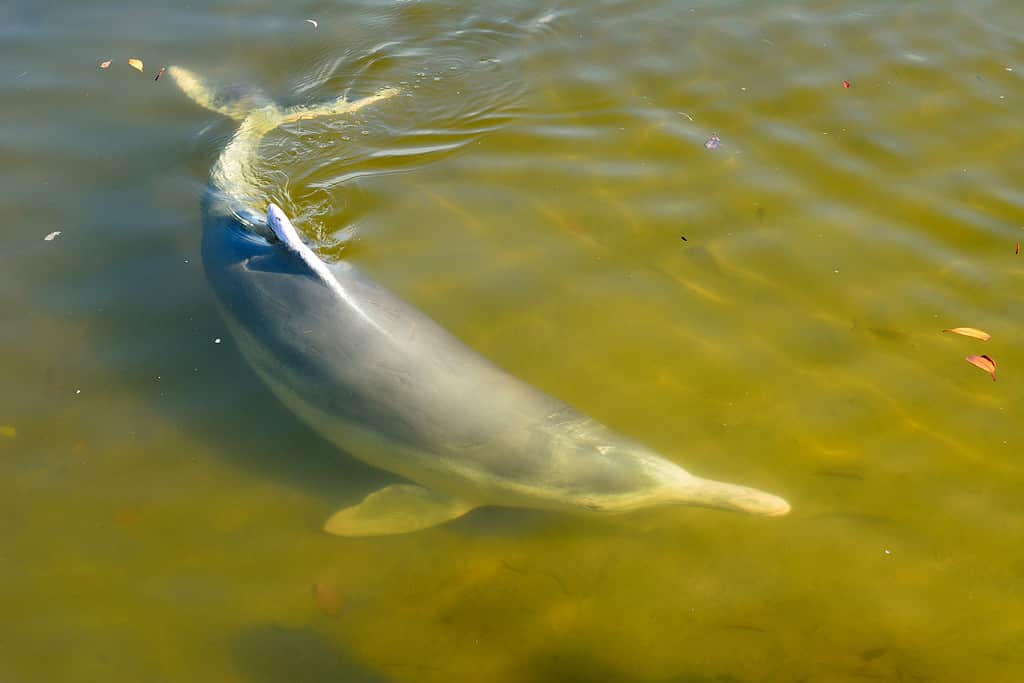
The Australian Humpback Dolphin (
Sousa sahulensis)was first described in 2014.
©Alizada Studios/Shutterstock.com
There are four extant species within the genus Sousa: the Indo-Pacific humpback dolphin (Sousa chinensis), the Indian Ocean humpback dolphin (Sousa plumbea), and the Atlantic humpback dolphin (Sousa teuszii), and the Australian Humpback Dolphin (Sousa sahulensis). These dolphins are known for their distinctive hump-shaped dorsal fin, which is larger and more curved than the dorsal fins of other dolphin species.
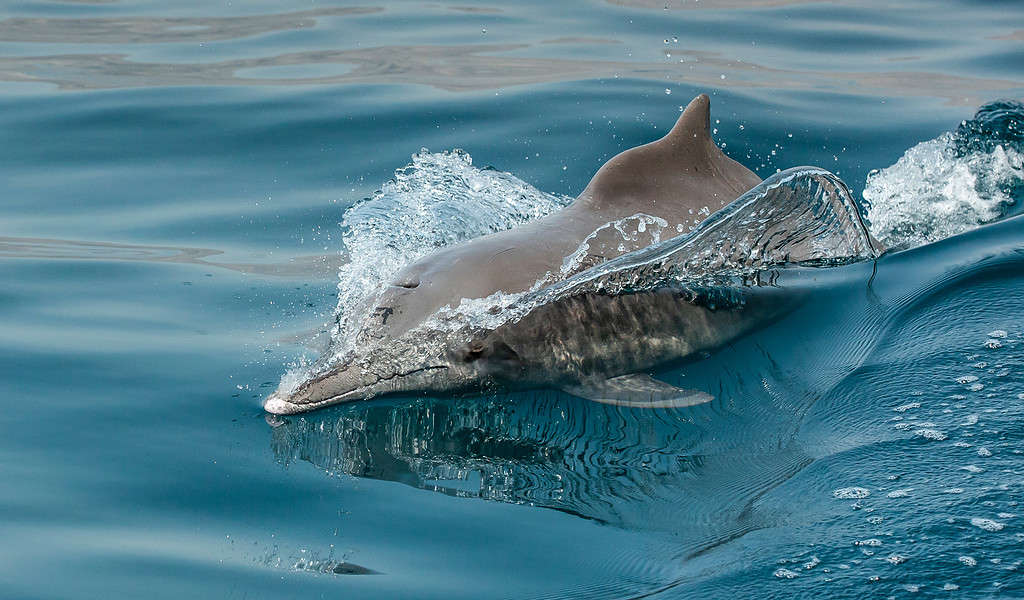
Humpback dolphins are known for their distinctive hump-shaped dorsal fin, which is larger and more curved than the dorsal fins of other dolphin species.
©Katiekk/Shutterstock.com
Humpback dolphins are social animals and are usually found in small groups or pods, ranging in size from just a few individuals to over 20. They are known for their intelligence, curiosity, and playful attitude, and are often seen riding the wakes of boats or playing with objects such as seaweed or pieces of wood.
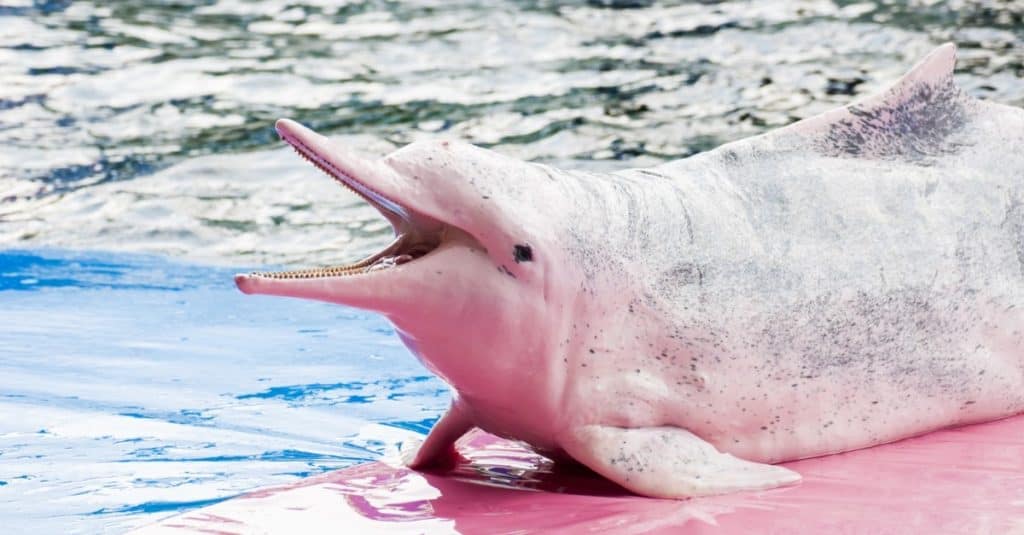
The Indo-Pacific humpback dolphin (Sousa chinensis) is characterized by its long beak and distinct coloration, which often includes a dark dorsal cape and lighter underside.
©wasanajai/Shutterstock.com
Sotalia
Dolphins in the genus Sotalia are found in the coastal waters of the Western Atlantic Ocean, ranging from the Southern Gulf of Mexico to Southern Brazil. There are two recognized species within the genus Sotalia: the tucuxi (Sotalia fluviatilis) and the costero (Sotalia guianensis).
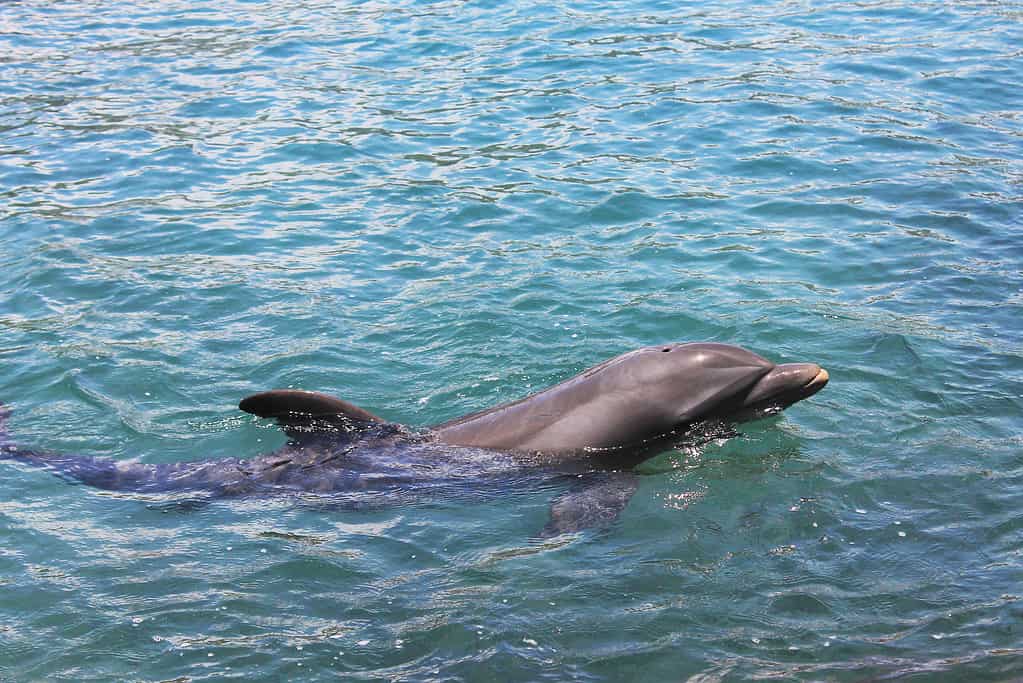
The costero (
Sotalia guianensis)is found in coastal waters.
©Melinaa.es/Shutterstock.com
The tucuxi is found mostly in freshwater rivers and estuaries, while the costero is found in marine coastal waters. Both species are highly social and are usually found in groups or pods, ranging in size from a few individuals to several dozen. Sotalia dolphins are known for their intelligence, curiosity, and playful behavior.

Tucuxi (
Sotalia fluviatilis) is found mostly in freshwater rivers and estuaries.
©Aleksei Verhovski/Shutterstock.com
Orcinus
There is only one extant species within the genus Orcinus: the killer whale (Orcinus orca). These animals are apex predators, known for their predatory skills and complex hunting strategies. Orcas are highly adaptable and have a varied diet, which can include fish, squid, seals, sea lions, and other marine mammals. Orcas are the largest member of the dolphin family and are highly intelligent and social animals.
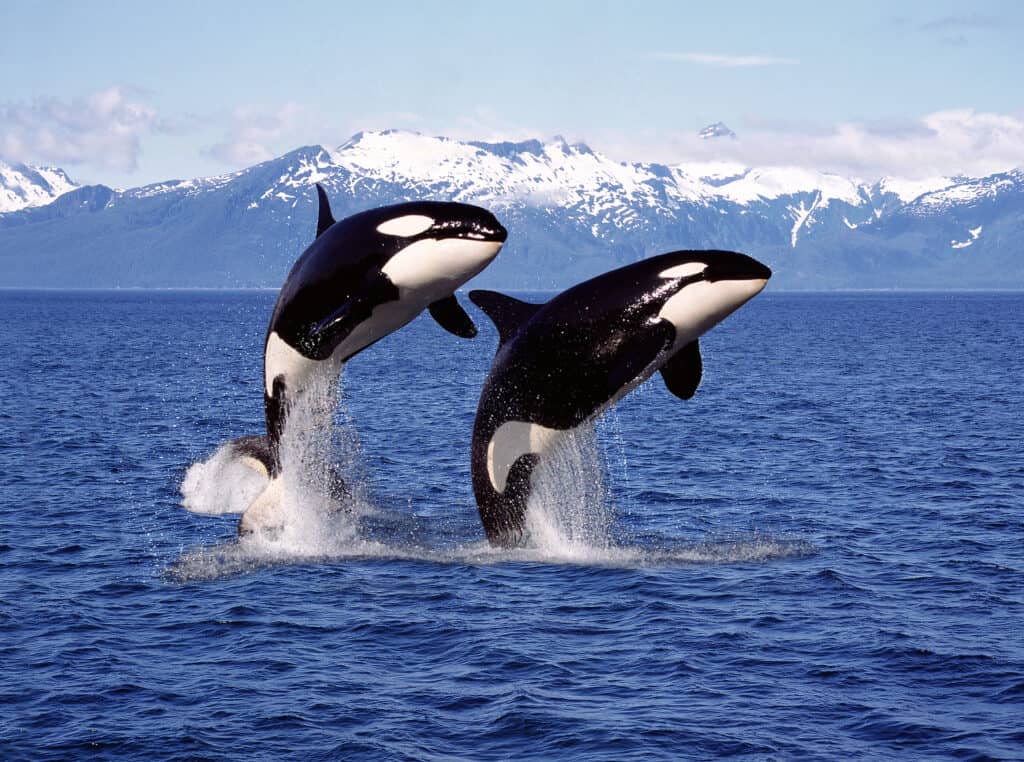
Orca pods are highly structured, with distinct social hierarchies and communication systems.
©slowmotiongli/Shutterstock.com
Orcas live in groups known as pods, which can range in size from just a few individuals to over 100. These pods are highly structured, with distinct social hierarchies and communication systems. Orcas are known for their vocalizations, which include whistles, clicks, and pulsed calls.
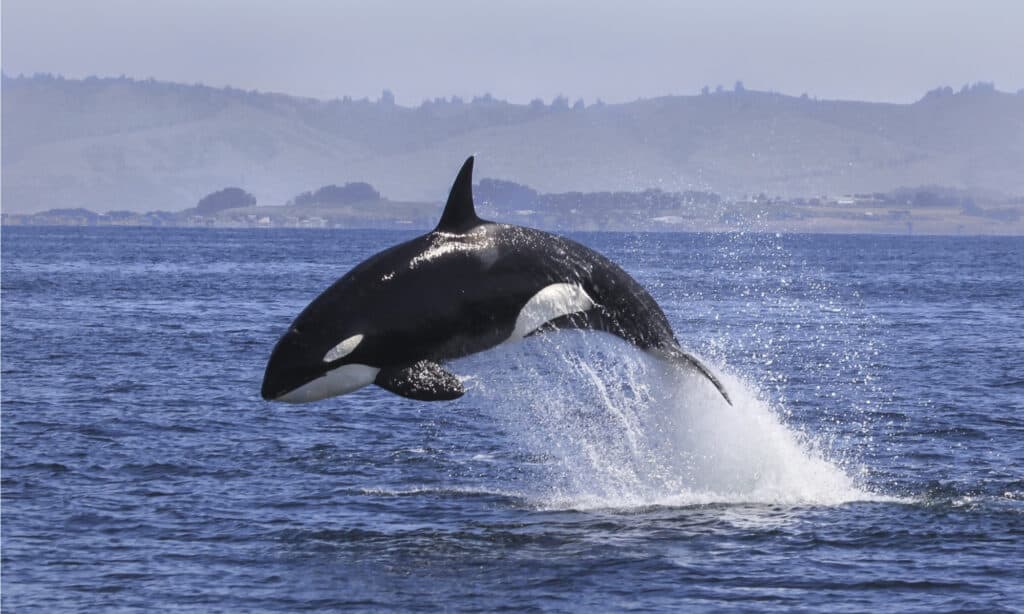
The orca, or killer whale (
Orcinus orca), is the largest of all dolphin species.
©Tory Kallman/Shutterstock.com
Feresa
Feresa is a monotypic genus, meaning it has only one species, Feresa attenuata, also known as the Pygmy killer whale or Lesser killer whale. Pygmy killer whales can reach lengths of up to 8.5 feet (2.6 m) and weigh up to 500 pounds (225 kg). They are found in the deep offshore waters of tropical and subtropical regions in all oceans. Pygmy killer whales are known to be relatively solitary and live in small groups of up to ten individuals. They are known to feed on squid, fish, and occasionally on small cetaceans. Despite their common name, Pygmy killer whales are not considered a significant threat to humans.
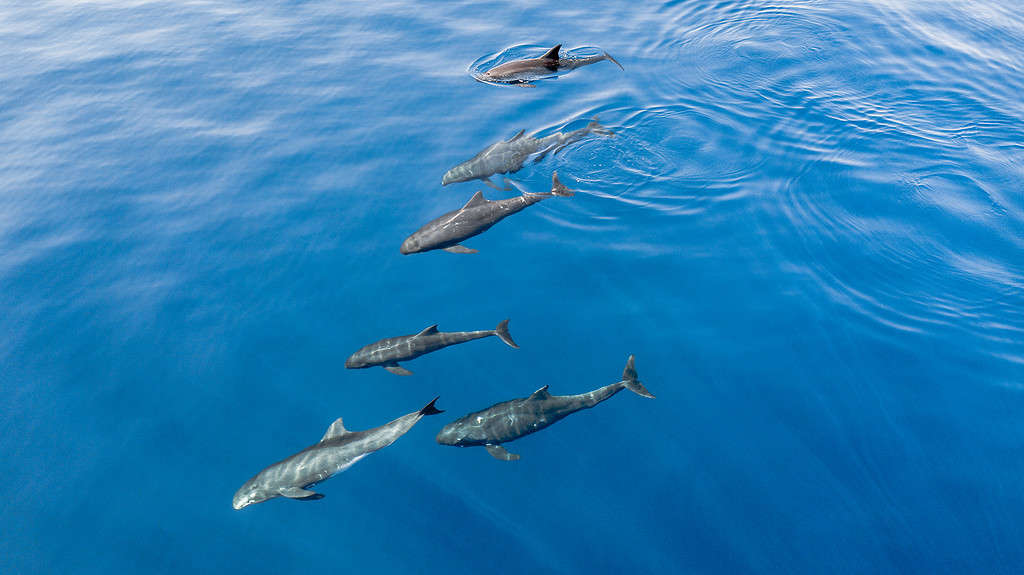
Pygmy killer whales
(Feresa attenuate), despite their common name, are not considered a significant threat to humans.
©Marcelo Johan Ogata/Shutterstock.com
Pseudorca
Pseudorca consists of one extant species, Pseudorca crassidens, commonly known as the False killer whale. False killer whales are large dolphins that reach lengths of up to 20 feet (6 meters) and weigh up to 3,000 pounds (1,400 kilograms). They have a dark gray or black body with a distinctive rounded forehead. The false killer whale is a cosmopolitan species that inhabits tropical, subtropical, and temperate waters in all oceans. They are highly social and are known to live in groups that can reach up to several hundred individuals. They are also known to form mixed-species groups with other cetacean species.
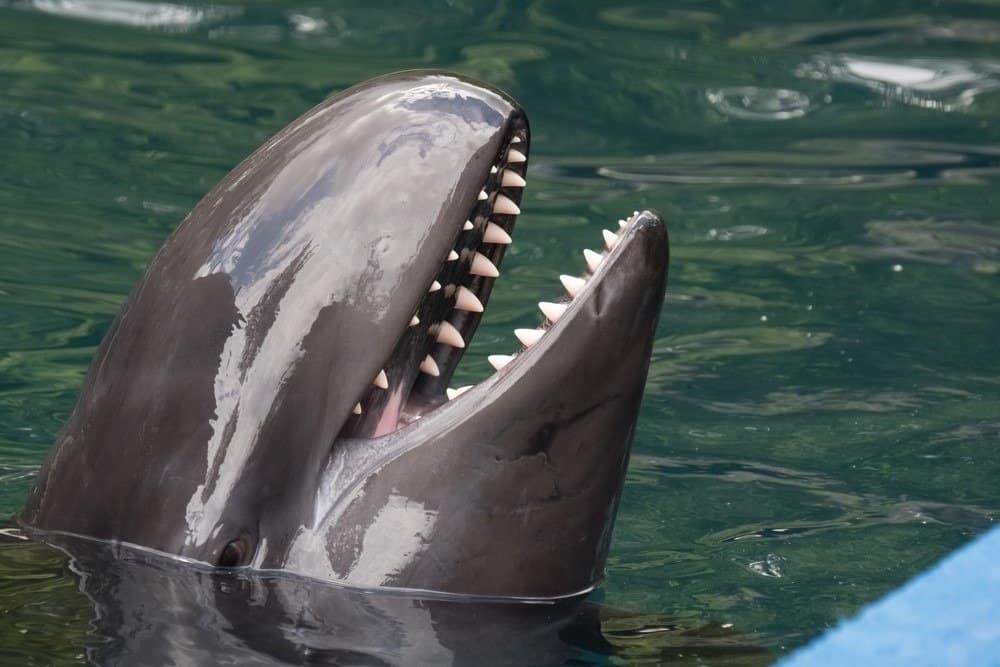
False killer whales (
Pseudorca crassidens) are large dolphins that reach lengths of up to 20 feet (6 meters) and weigh up to 3,000 pounds (1,400 kilograms).
©LouieLea/Shutterstock.com
False killer whales are apex predators and feed on a variety of prey, including fish, squid, and other marine mammals such as dolphins and small whales. They are known for their cooperative hunting behavior, where individuals will work together to corral and capture prey. Despite their name, false killer whales are not closely related to killer whales (Orcinus orca).

False killer whales (
Pseudorca crassidens)despite their name, are not closely related to killer whales (
Orcinus orca).
©Hawkeagle20/Shutterstock.com
Grampus
Another monotypic genus, Grampus consists of one extant species, Grampus griseus, commonly known as the Risso’s dolphin. Risso’s dolphins are medium-sized dolphins that are up to 13 feet (4 m) long and up to 1,100 pounds( 500 kilograms) in weight. They prefer deep offshore waters. They are generally solitary or live in small groups.

Risso’s dolphins (
Grampus griseus) often have numerous scars and scratches on their bodies, believed to be the result of interactions with squid, their primary prey.
©iStock.com/PeakMystique
Peponocephala
Only one extant species, Peponocephala electra, commonly known as the Melon-headed whale is contained in the genus Peponocephala Melon-headed whales are medium-sized dolphins that can reach lengths of 11.5 feet (3.5 m) and weigh 880 pounds (400 kg). Their body is dark gray or black, with a lighter gray patch on the belly. Melon-headed whales are found in tropical and subtropical waters of all oceans. They are highly social and live in groups of up to several hundred individuals. They are also known to form mixed-species groups with other cetacean species, such as pilot whales, and false killer whales. Melon-headed whales feed on a variety of prey, including squid, fish, and crustaceans. They are deep divers that will routinely dive hundreds of feet to find prey.
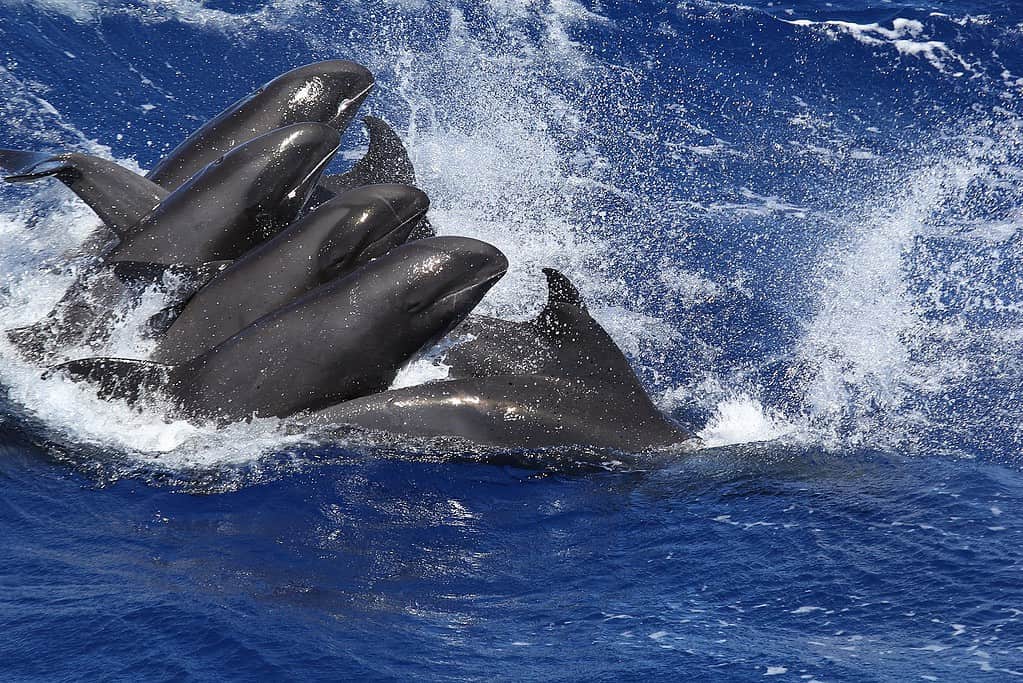
Melon-headed whales are highly social and live in groups of up to several hundred individuals.
©NOAA Photo Library, CC BY 2.0 , via Wikimedia Commons – License
Globicephala
The genus Globicephala consists of two extant species, the long-finned pilot whale (Globicephala melas) and the short-finned pilot whale (Globicephala macrorhynchus).
Pilot whales are large dolphins that can reach lengths of up to 21 feet (6.5 meters) and weigh up to 7,700 pounds (3,500 kg). They have bulbous heads and curved dorsal fins. Pilot whales are found in temperate and tropical waters of all oceans. They live in groups called pods that can reach up to several hundred individuals. Pilot whales are apex predators and feed on a variety of prey, including squid, fish, and other marine mammals such as dolphins and small whales. They are known for their cooperative hunting behavior, where individuals will work together to corral and capture prey.

Long-finned pilot whales (
Globicephala melas) are apex predators and feed on a variety of prey, including squid, fish, and other marine mammals such as dolphins and small whales.
©Andrew Sutton/Shutterstock.com
Orcaella
The genus Orcaella consists of one extant species, Orcaella brevirostris, commonly known as the Irrawaddy dolphin. Irrawaddy dolphins are small dolphins, 9 feet (3 m) long, weighing up to 440 pounds (200 kg). They have a stocky body, a rounded head with no beak, and a small dorsal fin. They have blunt foreheads and slightly upturned mouths that give them a permanent smile.
Irrawaddy dolphins are considered oceanic dolphins though they are found in freshwater and brackish water habitats of Southeast Asia including rivers as well as coastal waters. They are known for their ability to swim on their backs.
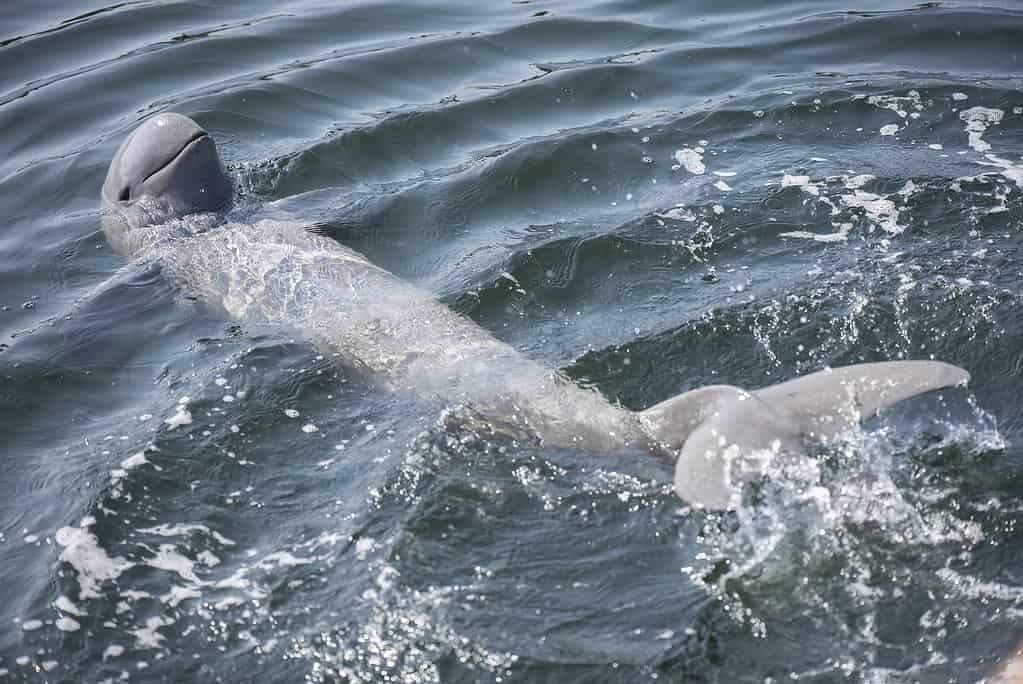
Irrawaddy dolphins
(Orcaella brevirostris) have blunt foreheads and slightly upturned mouths that give them a permanent smile.
©Isuaneye/Shutterstock.com
River Dolphins
Iniidae
The Iniidae is a family of river dolphins containing one living genus, Inia. These dolphins are adapted to living in the shallow coastal waters and estuaries of South America. These dolphins are small and recognized by their long beaks. There are two species in the genus Inia: Inia geoffrensis, commonly known as the Amazon river dolphin, pink river dolphin; and Inia boliviensis, the Bolivian river dolphin. These species are found in the rivers of South America and are members of the family Iniidae, also known as the river dolphin family.
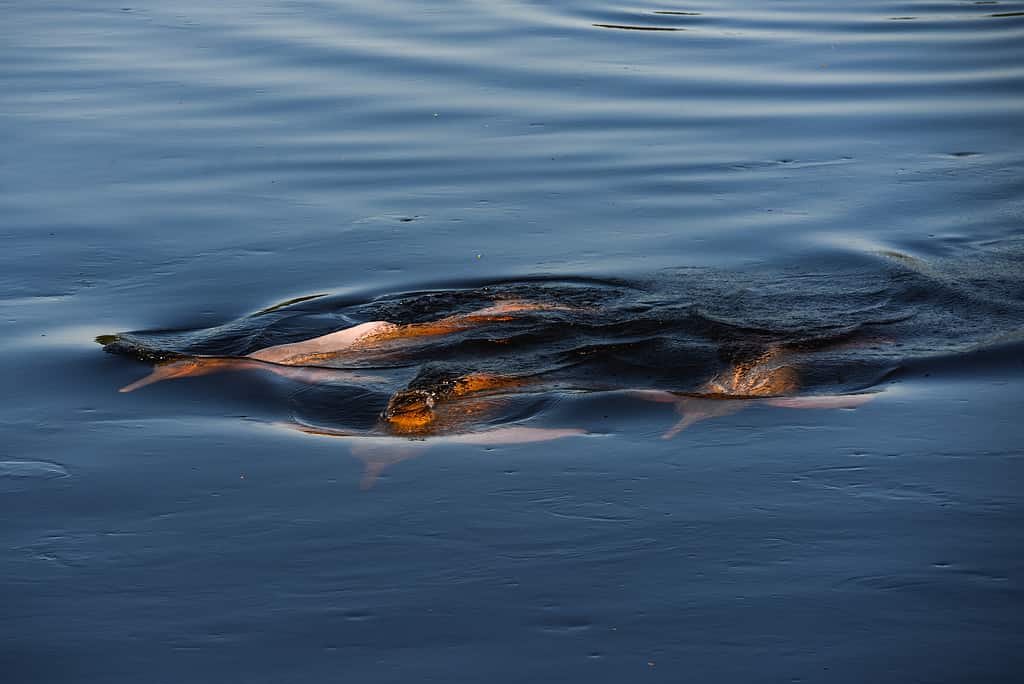
The Bolivian river dolphin (
Inia boliviensis)is found in the Madeira, Mamoré, and Beni rivers.
©Pedro Carrilho/Shutterstock.com
These two species have distinct differences. They have different geographic distributions, the Amazon river dolphin swims in the Amazon and Orinoco river basins, while the Bolivian river dolphin is found in the Madeira, Mamoré, and Beni rivers. Their coloration is also vastly different, as well. While Inia geoffrensis is generally pink or light gray in color, Inia boliviensis is darker, with a grayish-brown or brownish-black coloration, with a lighter belly.

The Amazon river dolphin or boto (I
nia geoffrensis) is found in the Amazon and Orinoco river basins.
©COULANGES/Shutterstock.com
Pontoporiidae
It consists of one extant species, Pontoporia blainvillei, commonly known as the Franciscana dolphin or La plata dophin. They are found along the Atlantic coast of South America, specifically in the coastal waters of Brazil, Uruguay, and Argentina.
The Franciscana dolphin is a small dolphin of 5 feet (2 meters), weighing 150 pounds (70 kilograms). It has a stocky, torpedo-shaped body with a rounded forehead and a short, stubby beak. Its coloration is gray to brown on its dorsal side, fading to a lighter shade on its ventral side.
Franciscana dolphins are found in shallow, coastal waters and estuaries, and are known to travel upstream into freshwater rivers.
Platanista
The genus Platanista contains two speices of South Asia river dolphins. The Indus river dolphin (Platanista minor) is found only in the Indus river system in Pakistan and India. The Ganges river dolphin or Susu (Platanista gangetica) are found in the rivers of India, Bangladesh, Nepal, and Bhutan.They are easily recognized by the their long, toothy beak.
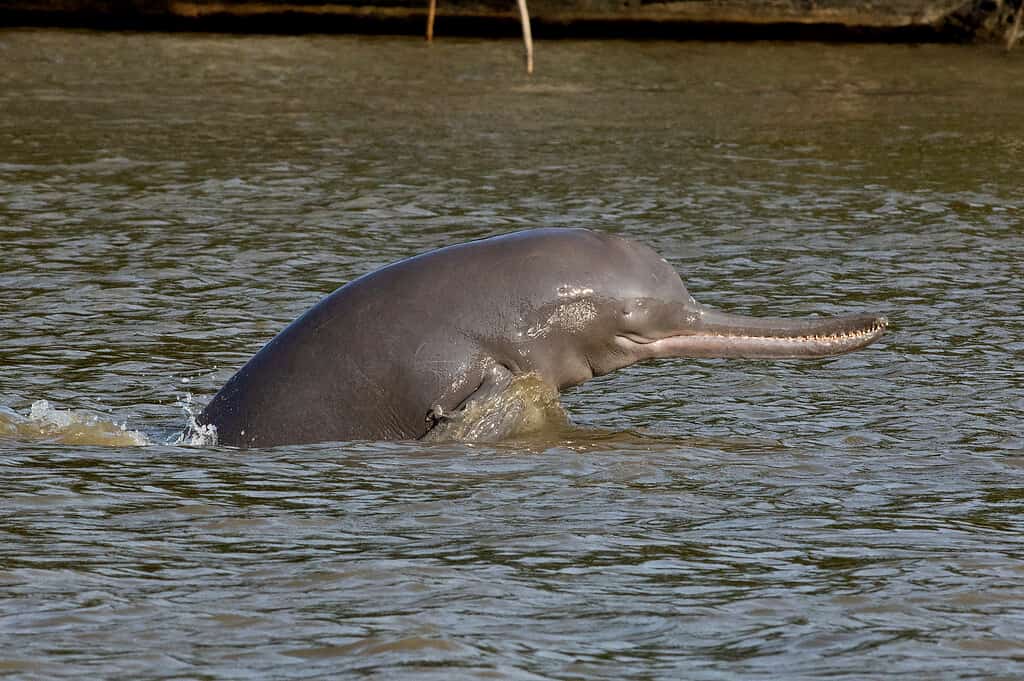
Ganges river dolphin or Susu
(Platanista gangetica) are found in the rivers of India, Bangladesh, Nepal, and Bhutan.They are easily recognized by the their long, toothy beak.
©Ranjan Barthakur/Shutterstock.com
Lipotes
The Baiji or Yangtze river dolphin (Lipotes vexillifer), now considered functionally extinct, was formerly found only in the Yangtze river system in China. The last living Yangtze river dolphin was seen in 2002.
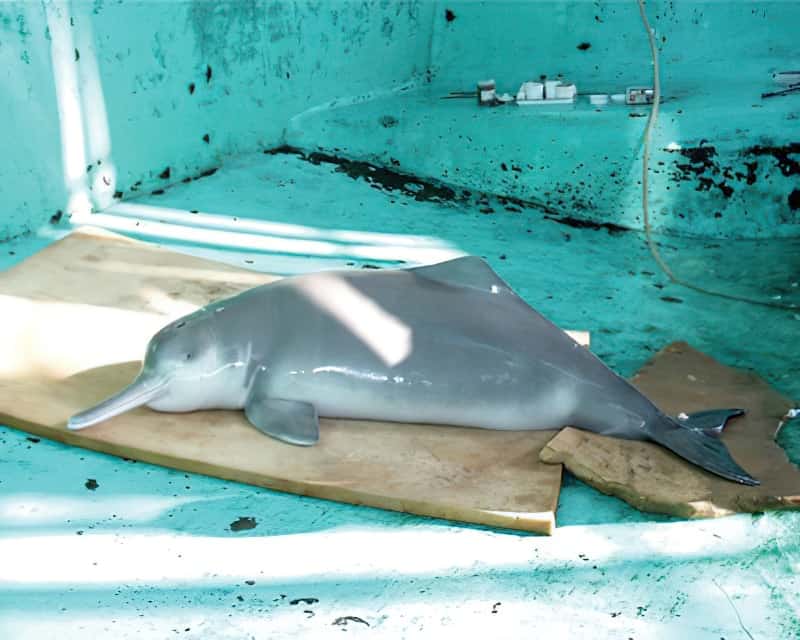
The last captive Chinese river dolphin (Lipotes vexillifer) was named Qiqi.
©Institute of Hydrobiology, Chinese Academy of Sciences / public domain, Wikimedia Commons – License
Porpoises
Porpoises are a group of small, toothed whales that are often confused with their larger and more well-known cousins, dolphins. While both dolphins and porpoises are members of the same family Cetacea, there are several key differences between them. Porpoises tend to be smaller than dolphins and have stockier, more torpedo-shaped bodies. They also have rounder heads and shorter snouts. Their teeth are flatter and spade-shaped, unlike the conical teeth of dolphins. Porpoises tend to be shy and solitary creatures, and while both species are known for their intelligence and playful nature, dolphins are often more acrobatic, performing a wider range of aerial tricks than porpoises.
Porpoises are classified into seven extant species that belong to three different genera: the Phocoenidae family includes four species in the genus Phocoena, while the genus Phocoenoides contained one species. Two species belong to the genus Neophocaena: the Indo-Pacific finless porpoise (Neophocaena phocaenoides) and the narrow-ridged finless porpoise or the Yangtze finless porpoise (Neophocaena asiaeorientalis).
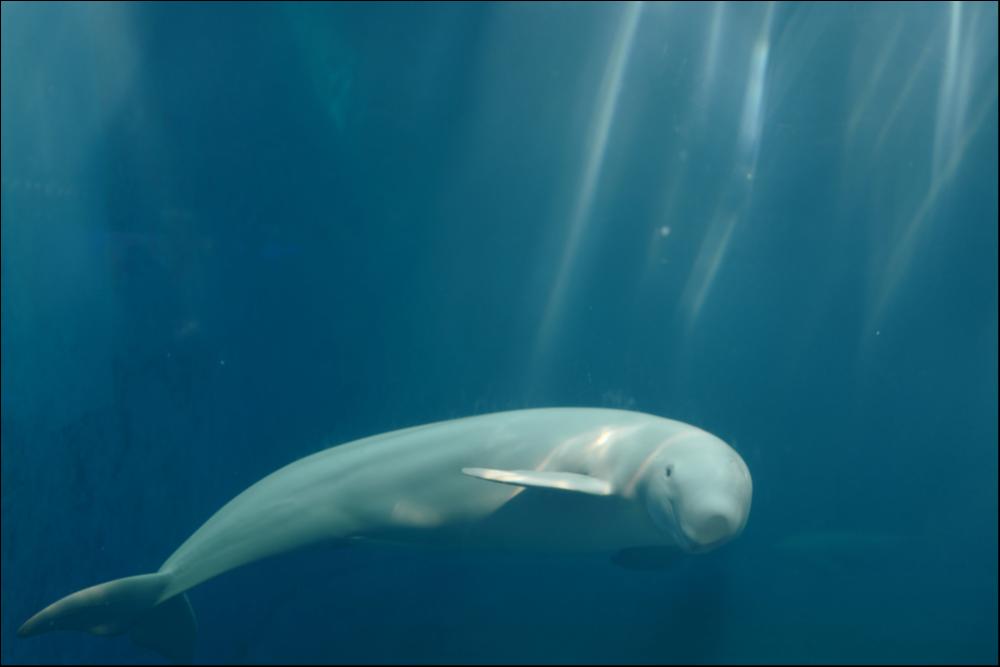
The Indo-Pacific finless porpoise (
Neophocaena phocaenoides) is widely distributed throughout coastal waters from the Taiwan Strait to the Persian Gulf.
©Pavaphon Supanantananont/Shutterstock.com
Phocoena
The four species belonging to the genus Phocoena are the harbor porpoise (Phocoena phocoena), the vaquita (Phocoena sinus), Burmeister’s porpoise (Phocoena spinipinnis), and spectacled porpoise (Phocoena dioptrica). There are also three recognized subspecies contained in the genus: There have also been three subspecies recognized including Phocoena phocoeana phocoena, Phocoena phocoena vomerine, and Phocoena phocoeana relicta.
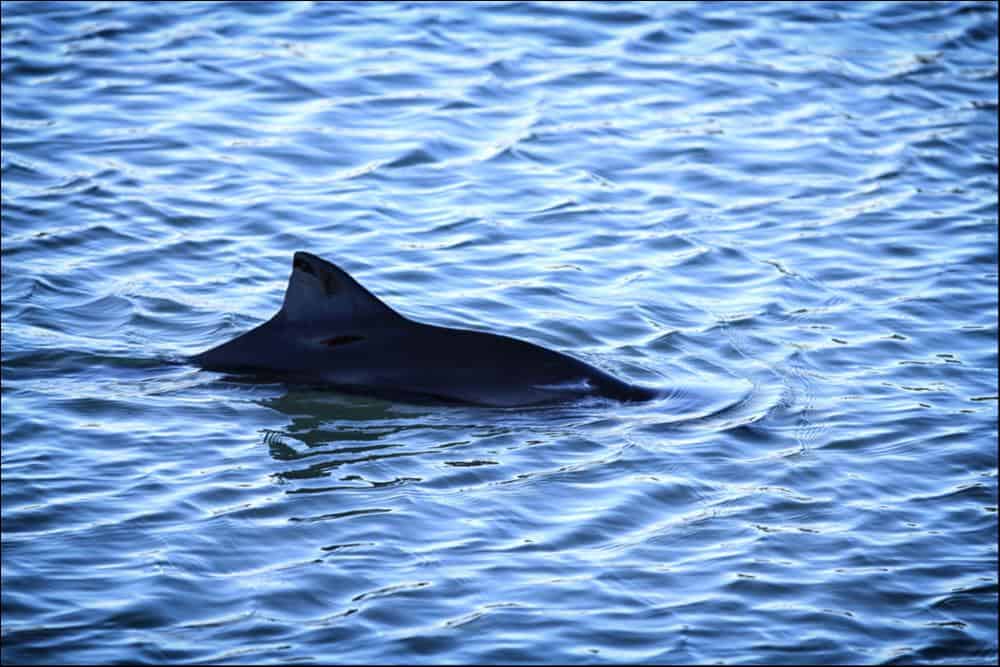
The common harbor porpoise (
Phocoena phocoena)is widely distributed along both coasts of North America an Western Europe
©Mark Caunt/Shutterstock.com
Vaquita (Phocoena sinus) is not widely distributed. They are found only in the upper Gulf of California in the Sea of Cortez.

Vaquita (
Phocoena sinus)is not a widely distributed species.
©Paula Olson, NOAA / Public domain, via Wikimedia Commons – License
Phocoenoides
Dall’s porpoise (Phocoenoides dalli) is the only species in the genus Phocoenoides. The Dall’s Porpoise is the largest porpoise species, reaching 7 feet (2.1 m) long and weighing 440 (200 kg). Dall’s porpoises are widely distributed throughout the Northern Pacific Ocean from California to Alaska.

The photo featured at the top of this post is © IgorZh/Shutterstock.com
Thank you for reading! Have some feedback for us? Contact the AZ Animals editorial team.




